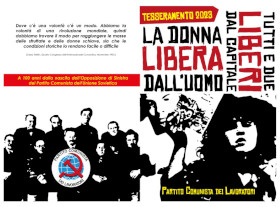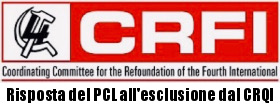Internazionale
Arms industry and Italian imperialism
5 Dicembre 2024
Trump’s victory in the U.S. is a further factor driving the arms race in Europe. The race has been going on for at least a decade in all the imperialist states of the old continent. The Russian invasion of Ukraine has accelerated its pace. Now the pace becomes frantic.
Even before the U.S. elections and their predictable outcome, the Draghi report had emphasized the need for a “common European defense” through two combined paths: raising the huge funds needed with a new extraordinary continental debt (an increase of 800 billion euros annually, 5 percent of EU GDP), and the gradual unification at the European level of the military-industrial complex. But both paths appear obstructed. On the one hand, German imperialism, in deep crisis, does not want to shoulder the burden of a new European debt. On the other, the various monopolies of the national military industries are elbowing each other to grab the increased orders and gain market space,
Transnational cooperations, which are multiplying, are also following this route.
Competition in combat aircraft production is emblematic. Britain, Germany, Spain, Italy cooperate in the production of the Eurofighter; France focuses on its Rafale; Sweden produces the Gripen. The future sixth-generation fighter-bomber (Tempest) sees the collaboration of British, Italian, and Japanese companies, with the blessing of their respective governments. France, not wanting to cooperate with the British military industry, opposes it with its own design, the Future Combat Air System (FCAS). Thus, the U.S. military industry keeps its supremacy firm, and cashes in on a good part of the same European military orders, over the protests of France.
European military spending ($313 billion euros in 2023) is overall three times that of Russia (which nevertheless grew in 2023 alone by 24%) but remains marked by strong fragmentation.
Italian imperialism moves within this overall framework.
Italian military spending has been growing for ten years (+ 61%). And it did not wait, as many think, for the Ukraine war. In 2020, in the midst of the Covid storm, the government headed by Giuseppe Conte (the one who today plays the “pacifist”) increased military spending in a single year by 9.6 percent, after agreeing in NATO to the famous commitment of 2 percent of GDP. The deep recessionary crisis in the aftermath of the pandemic partially slowed the race. But the current Meloni-Crosetto government pledges to make up for the “delays” by raising military spending to the record ceiling of 32 billion euros, and spending in new armaments alone to over 13 billion annually (40 billion over the three-year period). What was taken away from citizenship (basic) income, healthcare, schools, and social services is invested in militarism. A comparison with projected spending on hydrogeological disruption (floods) is striking: 1.8 billion.
Tricolor military companies are moving in the wake of this dynamic.
Leonardo (formerly Finmeccanica), the flagship company of patriotic militarism, is booming in profits and business. It is currently the second-largest military company in Europe behind Britain’s BAE Systems, with revenues exceeding 11 billion euros. But its sights go further. Leonardo aims to expand the production of military helicopters (with which it already equips the Zionist state) through collaboration with Airbus; it tries to climb the ranks in the “space” economy, leveraging its strong shareholding (33%) in Thales Alenia Space; and above all, it invests in the production of a new European heavy tank, the Main Ground Combat System (MGCS). Decisive in this regard is the joint venture with Germany’s Rheinmetall, with operational headquarters at OTO Melara in La Spezia. While another German company, Krauss-Maffei Wengmann (KNDS group), which produces the already well-known Leopard, contends with it.
Running parallel is Fincantieri. Its jump in the stock market over the past year is 34 percent. It now has an order backlog of 41.1 billion euros. Its main investment target is submarines. A worldwide market worth over 400 billion.
War dynamics drive big business. As Corriere della Sera states (11 November), «Submarines are among the most feared assets: they can be used to secretly map the critical infrastructure of enemy countries or, in the worst scenario, to sabotage or attack commercial and military ships». The seabed, moreover, is more strategic territory than ever, home to more than 1.4 million km of undersea cables, on which data and financial transactions flow daily. In the Mediterranean alone, over 320,000 km of gas and oil pipelines.
In its history Fincantieri has produced more than 180 submarines, and today it is at the forefront of honoring the new tricolor demand. Both through the production of underwater drones, manned and unmanned, «cheap and tremendously effective means… for defense and, in the case, also for attack» (Corriere della Sera); and through the design of new nuclear submarines commissioned to Fincantieri by the Ministry of Defense, complete with the involvement of the University of Genoa. It is in the National Military Research Plan 2023, called “Minerva — Marinization of nuclear power plant for on-board energy of armed vessels.”
Fincantieri’s big ambition is to get its hands on Germany’s ThyssenKrupp Marine Systems, and the Kiel shipyards, which specialize in building naval ships and submarines. Perhaps through a 50-50 joint venture that would allow a huge jump in productive capacity and global clout.
The growth of the Italian military industry is combined with the role of patriotic imperialism on an international scale. Not surprisingly, planned spending on military missions in which Italy is involved, often with a major role, goes up.
This is the case with Italy’s role in the Middle East. First in the Red Sea, in a military mission voted in parliament by a broad front of national unity (from Fratelli d’Italia to the M5S, and the PD), openly arrayed against the Houthis, in defense of ships heading to the ports of occupied Palestine. That is, in defense of Israel.
But also in Lebanon, where Italy plays a central role in the so-called UNIFIL (1,200 troops) “peacekeeping mission.” A mission undertaken in 1978, and then much strengthened in 2006 with the decisive help of the government of Romano Prodi (in which Rifondazione Comunista participated). A mission originally born with the purpose (failed) of facilitating the disarmament of Hezbollah by the Lebanese government in order to compensate and redeem the defeat of the Israeli invasion of Lebanon at the time; and today committed to renegotiate with the Lebanese authorities the disarmament of Hezbollah, under the whip of the new Zionist war of invasion, against the backdrop of the massacre of the Palestinians.
All the more so today, the “application” of the famous UN Resolution 1701 as a “peacekeeping” solution, in fact means exactly that – to help the reconstruction of a Lebanese military force that can complete, as “peacefully” as possible, the dirty work of the Zionist state, with the blessing of the other regional actors and imperialist allies. Meloni and Crosetto call “peace” a Lebanon cleansed of pro-Palestinian resistance. To this end, they call on allied imperialisms to agree on new rules of engagement for the UNIFIL mission. Meanwhile, they nominate the Carabinieri for the role of trainers of a future military law and order police in Palestine, a role, moreover, already performed in the service of Palestinian National Authority police in the West Bank.
But the commitment of Italian imperialism is projected on a global scale, far beyond the Middle East. «Maneuvers in the South China Sea, the first flight of Italian ships», as the liberal progressive newspaper La Repubblica (13 September) emphatically hails the role of the aircraft carrier Cavour in military operations in the Pacific. For the “first time” an Italian aircraft carrier leads a naval group composed of American, French, Spanish, German, Australian, and Japanese ships. «The group set sail from Taranto in early June, crossed the Suez Canal and in the Red Sea began training activities with the U.S. aircraft carrier Roosevelt, and then continued in Australia, participating in the Pitch Black exercise that saw the transfer of the latest generation of fighter jets to bases in Oceania» (La Repubblica). The training goes through two combat simulations: the first saw the ultra-modern F-35B fighters and the more seasoned Harriers engaged in the virtual repulsion of «enemy squadrons»; the second saw the coordinated action of ships, planes, helicopters to «hunt down a threat in the depths».
Minister Crosetto justified the operations, and related Italian participation, with these words: “We are forging deeper ties with friendly countries because we want to maintain freedom of navigation and maritime security in this region in order to promote trade and protect supply chains”. What you don’t do for “freedom”.
The Pacific is increasingly looking to be the main theater of the collision between U.S. imperialism and Chinese imperialism. A declining but still dominant imperialism and a rising imperialism with rising ambitions. It is the potential site of a future great war for the partition of the world. The extension of NATO over the Pacific, with the enlistment of Japan, South Korea, and Australia, is part of the preparation for war. As is on the opposite side, the Chinese claim on Taiwan. Italian imperialism is not a spectator but a participant in the US-led grand alliance. And it does not want to remain in the second row. Just as Leonardo and Fincantieri do not want to. Imperialism at home is first and foremost tricolor imperialism.










